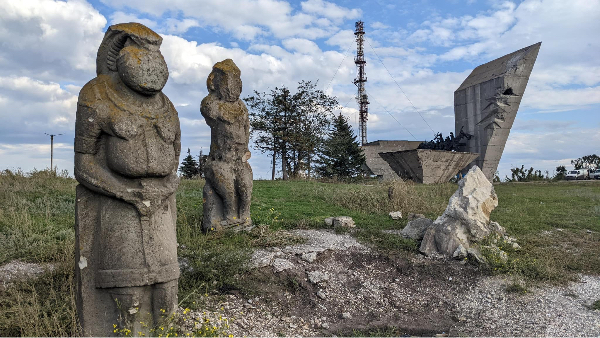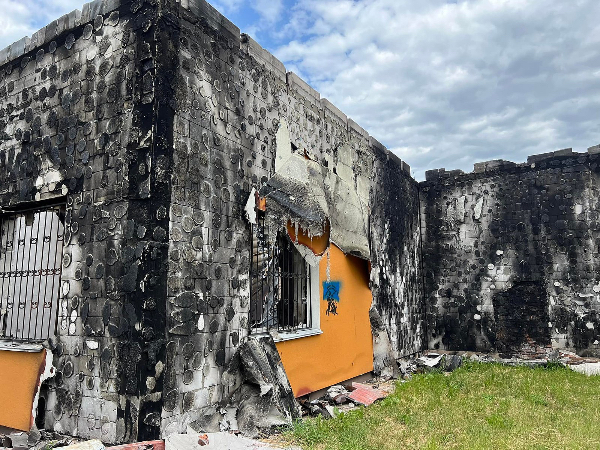Researchers from William & Mary Anthropology Involved in the Smithsonian's Cultural Rescue Initiative

Cultural heritage in Ukraine threatened by war: damaged Cuman/Polovtsian sculptures (9th to 13th centuries CE) and WWII memorial in Izium. Image credit: Ministry of Culture and Information Policy of Ukraine. Image license: Creative Commons Attribution 4.0 International license. File reduced in size for this article.
Several researchers from William & Mary’s Anthropology Department have been involved in the work of the Smithsonian Cultural Rescue Initiative (SCRI) and its partners – namely the Cultural Heritage Monitoring Lab (CHML). CHML, which is housed at the Virginia Museum of Natural History (VMNH), is directed by VMNH Archaeology Curator and William & Mary Anthropology Adjunct Professor Hayden Bassett. Anthropology Ph.D. Candidate Madeleine Gunter-Bassett and undergraduate Abby Maher are CHML analysts. Together, Hayden, Madeleine, and Abby have been making important contributions to the preservation of crucial forms of tangible heritage through the monitoring of heritage sites in areas of conflict.
As described in a Smithsonian Magazine article on SCRI’s work (see below), SCRI and its partners have been involved in several efforts to protect cultural heritage sites (i.e., monuments and memorials, places of worship, cemeteries, museums, libraries, archives, performing arts centers, historical buildings, and archaeological sites) threatened by armed conflict and natural disaster. SCRI responded to the earthquakes in Haiti (2010) and Nepal (2015), as well as to museum bombings in Syria and Iraq.
The Cultural Heritage Monitoring Lab – which Hayden, Madeleine, and Abby are a part of – was established by curator and former U.S. army “monuments woman” Cori Wegener in partnership with the Virginia Museum of Natural History. The team examines the status of cultural sites in crisis zones based on methods developed for Syria and Iraq during the years of conflict that afflicted those countries. The team has used satellite imagery to examine and monitor cultural damage caused by wars, natural disasters, and other destructive forces across the world, including Haiti, Afghanistan, and regions contested by Armenia and Azerbaijan.

Ruins of the Ivankiv Historical and Local History Museum, Kyiv Oblast, Ukraine. The museum, which housed archaeological collections from Ukraine and beyond, was destroyed following Russian bombardment during the Battle of Ivankiv. Image credit: Ministry of Culture and Information Policy of Ukraine. Image license: Creative Commons Attribution 4.0 International license. File reduced in size for this article.
Most recently, SCRI and CHML have focused their efforts on monitoring cultural heritage sites threatened by the ongoing war in Ukraine. CHML uses satellite imagery and remote sensing methods to monitor sites and document evidence of damage. This work has aided the planning of broader on-the-ground efforts to protect and evacuate heritage that is under threat so that it’s kept secure for the benefit of future generations of Ukrainians following the end of the war. Kudos to those at William & Mary who have been involved in these vital efforts to preserve the threatened cultural patrimony of Ukraine during this time of crisis.
Source: Kurin, R. (2023, Ferbuary 22). How Ukrainians Are Defending Their Cultural Heritage From Russian Destruction. Smithsonian Magazine. https://www.smithsonianmag.com/smithsonian-institution/ukrainians-defend-their-cultural-heritage-russian-destruction-180981661/
 Skip to main content
Skip to main content
